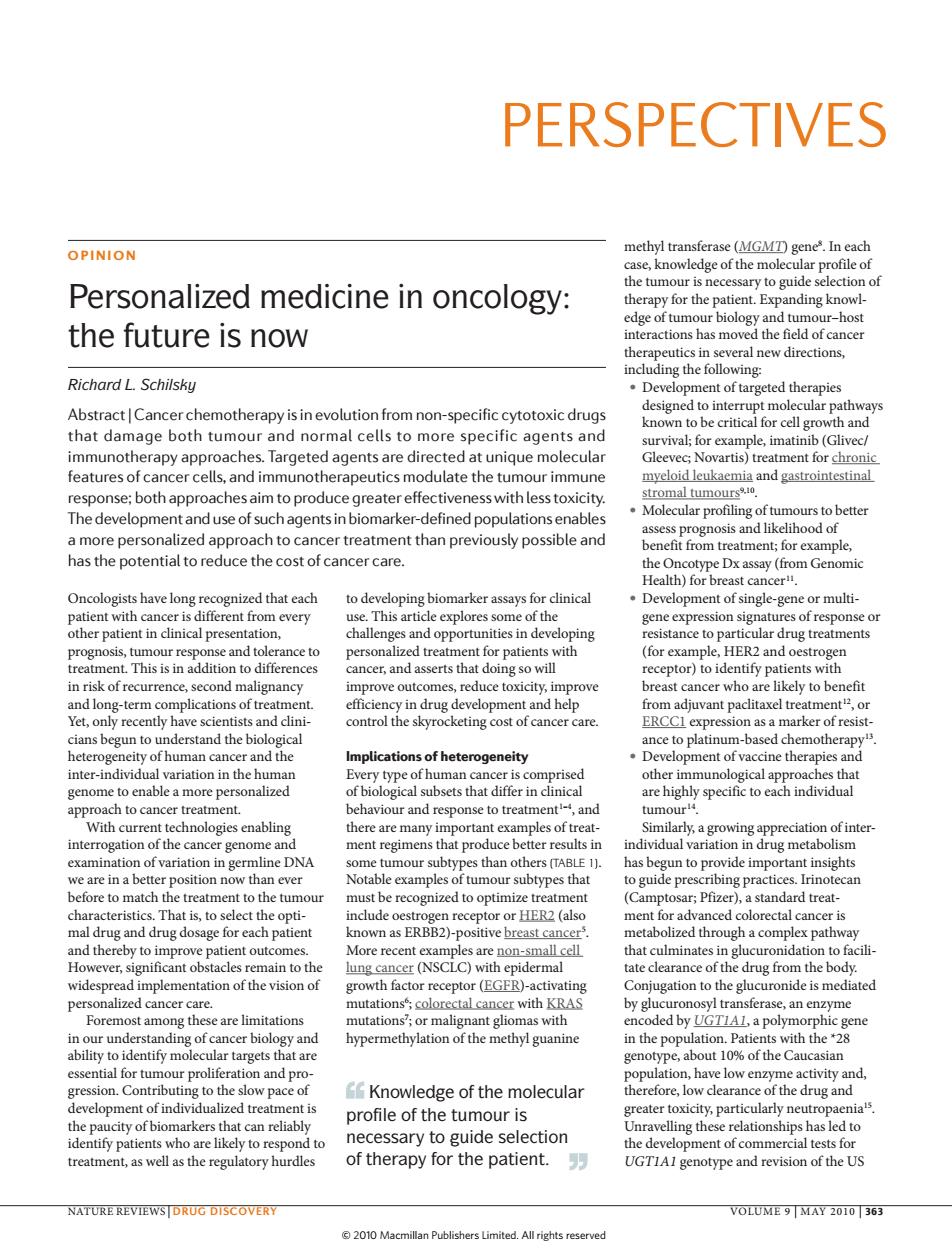正在加载图片...

PERSPECTIVES OPINION Personalized medicine in oncology: the tumour is ne the future is now Richard L Schilsky Abstract|Cancer chemotherapy isinevolution from non-specific cytotoxicdrugs that damage both tumour nd normal cells to more specific agents and vec immunothe oaches.Targeted agents are directed at unique molecular features of cancer cells.and immunotherapeutics modulate the tumour immune myeloid gastrointestinal response:both approaches aim to produce greater effectiveness with less toxicity. The development and use of such agents in biomarker-defined populations enables a more personalized approach to cancer treatment than previously possible and has the potential to reduce the cost of cancer care. Health)for bre ebpmentofeggreme lar drug treatments n risk of recurrenc rove ERCCI Expression as a marker of resist Implications of heten anc to platinum-based chemotherapy ype of human othe e to intothe cancer genom there are many important ex appreciation of inter ment regimens that pro dua rug n we are in a better (e a sta d trea ancer cili wtcpreadpknmeaaioafhevba rowth factor receptor (EGER)- ctivating Coniugation to the glu uronide is mediated imitations nutations or malie hypermethylation of the methyl guanine gm essential for tum Knowledge of the molecular the drug and profile of the tumour is the paucity of biomarkers that can reliably necessary to guide selection regu of therapy for the patient. NATURE REVIEWSIDRUG DISCOVERY VOLUME 9IMAY 20101363 2010 Macmillan Publishers limited.All rights reservedOncologists have long recognized that each patient with cancer is different from every other patient in clinical presentation, prognosis, tumour response and tolerance to treatment. This is in addition to differences in risk of recurrence, second malignancy and long-term complications of treatment. Yet, only recently have scientists and clinicians begun to understand the biological heterogeneity of human cancer and the inter-individual variation in the human genome to enable a more personalized approach to cancer treatment. With current technologies enabling interrogation of the cancer genome and examination of variation in germline DNA we are in a better position now than ever before to match the treatment to the tumour characteristics. That is, to select the optimal drug and drug dosage for each patient and thereby to improve patient outcomes. However, significant obstacles remain to the widespread implementation of the vision of personalized cancer care. Foremost among these are limitations in our understanding of cancer biology and ability to identify molecular targets that are essential for tumour proliferation and progression. Contributing to the slow pace of development of individualized treatment is the paucity of biomarkers that can reliably identify patients who are likely to respond to treatment, as well as the regulatory hurdles to developing biomarker assays for clinical use. This article explores some of the challenges and opportunities in developing personalized treatment for patients with cancer, and asserts that doing so will improve outcomes, reduce toxicity, improve efficiency in drug development and help control the skyrocketing cost of cancer care. Implications of heterogeneity Every type of human cancer is comprised of biological subsets that differ in clinical behaviour and response to treatment1–4, and there are many important examples of treatment regimens that produce better results in some tumour subtypes than others (TABLE 1). Notable examples of tumour subtypes that must be recognized to optimize treatment include oestrogen receptor or HER2 (also known as ERBB2)-positive breast cancer5 . More recent examples are non-small cell lung cancer (NSCLC) with epidermal growth factor receptor (EGFR)-activating mutations6 ; colorectal cancer with KRAS mutations7 ; or malignant gliomas with hypermethylation of the methyl guanine methyl transferase (MGMT) gene8 . In each case, knowledge of the molecular profile of the tumour is necessary to guide selection of therapy for the patient. Expanding knowledge of tumour biology and tumour–host interactions has moved the field of cancer therapeutics in several new directions, including the following: • Development of targeted therapies designed to interrupt molecular pathways known to be critical for cell growth and survival; for example, imatinib (Glivec/ Gleevec; Novartis) treatment for chronic myeloid leukaemia and gastrointestinal stromal tumours9,10. • Molecular profiling of tumours to better assess prognosis and likelihood of benefit from treatment; for example, the Oncotype Dx assay (from Genomic Health) for breast cancer11. • Development of single-gene or multigene expression signatures of response or resistance to particular drug treatments (for example, HER2 and oestrogen receptor) to identify patients with breast cancer who are likely to benefit from adjuvant paclitaxel treatment12, or ERCC1 expression as a marker of resistance to platinum-based chemotherapy13. • Development of vaccine therapies and other immunological approaches that are highly specific to each individual tumour14. Similarly, a growing appreciation of interindividual variation in drug metabolism has begun to provide important insights to guide prescribing practices. Irinotecan (Camptosar; Pfizer), a standard treatment for advanced colorectal cancer is metabolized through a complex pathway that culminates in glucuronidation to facilitate clearance of the drug from the body. Conjugation to the glucuronide is mediated by glucuronosyl transferase, an enzyme encoded by UGT1A1, a polymorphic gene in the population. Patients with the *28 genotype, about 10% of the Caucasian population, have low enzyme activity and, therefore, low clearance of the drug and greater toxicity, particularly neutropaenia15. Unravelling these relationships has led to the development of commercial tests for UGT1A1 genotype and revision of the US O pInI On Personalized medicine in oncology: the future is now Richard L. Schilsky Abstract | Cancer chemotherapy is in evolution from non-specific cytotoxic drugs that damage both tumour and normal cells to more specific agents and immunotherapy approaches. Targeted agents are directed at unique molecular features of cancer cells, and immunotherapeutics modulate the tumour immune response; both approaches aim to produce greater effectiveness with less toxicity. The development and use of such agents in biomarker-defined populations enables a more personalized approach to cancer treatment than previously possible and has the potential to reduce the cost of cancer care. Knowledge of the molecular profile of the tumour is necessary to guide selection of therapy for the patient. PersPeCTives NATURE REvIEWS | Drug Discovery vOLUME 9 | MAY 2010 | 363 © 2010 Macmillan Publishers Limited. All rights reserved